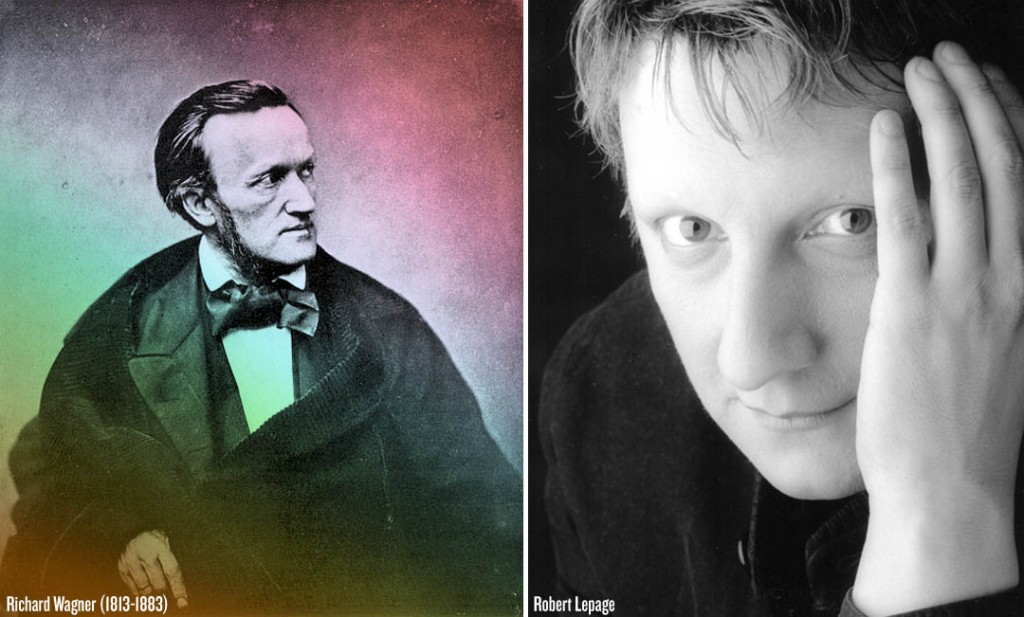On Monday night I happened to be flipping through the channels and came across the beginning of PBS’ brand new documentary Wagner’s Dream. From the very first minute I was glued to my seat, immersed in a story so enthralling even Richard Wagner (1813-1883) himself would have been mesmerized. Directed by acclaimed documentary filmmaker Susan Froemke, the film chronicles the 5-year journey undertaken by master director Robert Lepage who was commissioned by the METropolitan Opera in New York to bring Wagner’s 4-part, 16-hour Ring Cycle into the 21st century. And to say Lepage got the job done would be the understatement of the century.
The journey begins five years ago inside Lepage’s groundbreaking Quebec City studio Ex Machina, where Lepage began the initial concept development for the massive undertaking. Stumped at first, Lepage decided to take a trip to Iceland which is where Wagner began his own Ring Cycle journey. Thirteenth century nordic myths were the original source inspiration for Wagner, and they provided him with the narrative skeleton for his epic. The most important of all being the Poetic Edda, a collection of Old Norse poems primarily preserved in the Icelandic mediaeval manuscript Codex Regius. Along with Snorri Sturluson’s Prose Edda, the Poetic Edda is the most important extant source on Norse mythology, and it is here where anyone attempting to reimagine Wagner’s masterpiece must begin. Lepage was not only overtaken by the power and beauty of these treasured pages, he was equally enchanted by the geology of Iceland itself. It was this cracking, buckling, hissing, and steaming landscape which gave rise to the true star of the show: Lepage’s ingenious set piece which has became known as “The Machine”. The Hollywood Reporter writes:
Lepage’s staging — built around a 90,000 pound machine whose independently moving planks twist to evoke myriad mythological settings — is technically daring enough to occupy the documentary’s first hour. Initially, it’s difficult to believe the thing will work without killing anyone.
The doc continues to follow Lepage as he works out the kinks of his gigantic moving “toy” as he affectionately calls it, through to The Machine’s installation inside the MET’s New York stage. The gigantic apparatus is so heavy that engineers had to reinforce the structure of the MET itself to keep the stage from collapsing as The Machine needs to not only hold its own in place, but also must be wilded off the side of the stage in order for other productions to take place as well.
Wagner’s Dream introduces us to other pivotal figures in the story, including the man whose idea it was to engage Lepage in the first place — the MET’s newly-appointed General Manager Peter Gelb, who deserves the biggest credit of all for embarking on such a daring undertaking. Under enormous pressure by the administration of the MET to balance the books, and restore the MET’s fading reputation as the crown jewel of opera, Gelb will go down in the history books as the man who shook up the stuffy, often Grinch-like opera community, and proved to the world once again that the only way one can give rise to truly indelible magic is to step outside one’s comfort zone. Together, Gelb and Lepage will go down in history as modern opera’s greatest heroes.
Wagner’s Dream is so brilliant, some MET officials might even be tempted to go META and build an entirely new opera around the making-of Lepage’s Ring Cycle. I have a feeling if Wagner was alive today he would be the first to dream of writing it. His source material this time, however, would be Susan Froemke’s exquisite film. To find out when Wagner’s Dream is playing next be sure to visit PBS.org. Furthermore, PBS is currently airing each of the four parts of The Ring Cycle from now until September 14th. And if you’re lucky enough to find yourself in New York during the spring of 2013 you can see the performances live in person — nothing less than history in the making. For schedules and ticket information you can visit The METropolitan Opera. And for more information on the documentary be sure to visit WagnersDream.METoperafamily.org.


